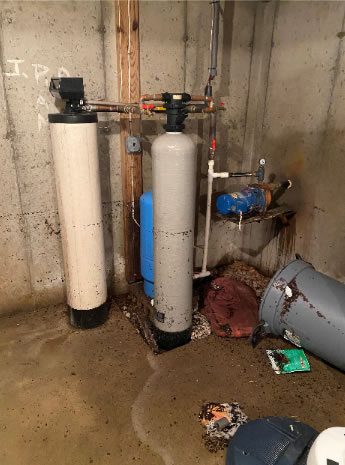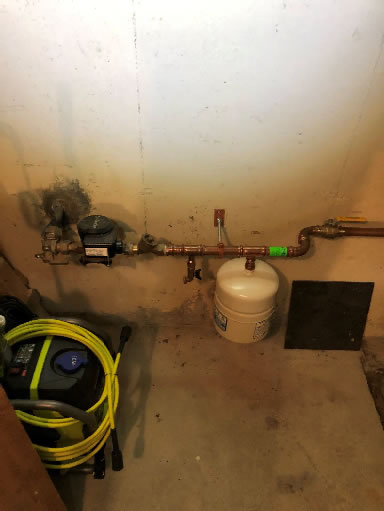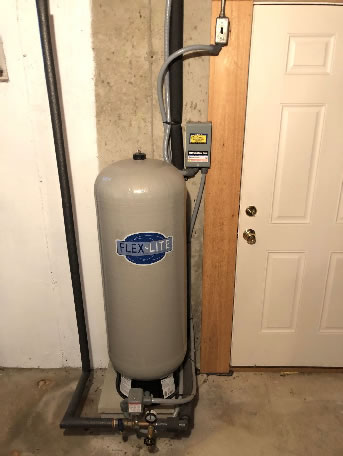You can lead a horse to water but from time to time
It dies of dehydration at the river’s edge.
Jon Clark 1998
I have pitched this in one-on-one discussions countless times and whether it’s the disruption of routine brought on by an uptick in visits or loaning out houses during COVID, there are a remarkable number of homes that have the water on at the main which has absolutely zero upside.
In ideal situations, the first thing I do, unless told otherwise or if a home is on a Tiger loop*, is to turn on the water main or well tank. The first leg of the exercise is to wait until the flow stops which assures, we have zero breaches as the system is pressurized. Next, it will replenish any required make-up water that may have dissipated in forced hot water systems. I will then turn off the main and in cases of a well, I will turn off the shut off lever as well as the switch to the well pump. Throughout the course of the ensuing walkthrough, I will flush toilets [a byproduct is keeping rubber components wet rather than let them dry, crack and then leach water via seeping based on the decay] and open sinks to relieve pressure in the supplies. The premise here is that should we encounter conditions that would freeze up domestic and heat supplies, the diminished volume in the lines would not be enough to expand to a breaking point.
In a situation where we have a freeze up, the possibility would be revealed when the meter ceases to stop spinning…i.e. we never come up to pressure. At this point, I would seek turn off the main and out the breach, a vastly cleaner discover process rather than a two-week literal soak.
What spooks most from turning the water off is that forced hot water heating systems will not work. In cases where the main is off, forced systems would take weeks to months to become air bound to the extent that they would trip out. I have a handful of cases where geothermal systems and furnaces created in the same year steel was invented where the water stays on constantly but for all others, particularly force hot air systems, we’re flipping Mother Nature the bird leaving mains and wells on.
Having just left a basement, exterior access only, with about 8” of standing water, I figured I’d launch this PSA now rather than wait on the next riveting newsletter. I have never marketed from a perspective of fear and have no plans to do so but one of the biggest misconceptions is that if we aren’t below freezing, we can expect a steady diet of sunshine and lollipops and on the conservative side, I would say that about 75% of the calamities I’ve run into were in conditions north of 40 degrees.
I took a call in October from one of my favorite couples who I don’t typically start until December and when I was told of an outrageous electric bill, I knew we had an issue with the water pump. Sure enough…

…the plug on end of the elevated water pump blew out and discharged water filling the basement until it shorted the pump out evidenced by the rust on the unit. Had that “light switch” between the two filter tanks been turned off, my dear customers may have been spared the hassle of switching out furnaces, a washer, dryer, pair of dehumidifiers and a handful of personal items.
This following is a typical municipal meter setup.

The physical meter is the black plastic component on the right. The rule of thumb is that should a pipe split, the town is responsible for anything from the street up to the meter. If the meter freezes, you own it. In turn, it is always wise to turn off the valve to the left of the meter between the foundation and actual meter. While setups will vary, the yellow lever on the right is a supplemental shutoff. While turning this off will isolate the house, a split from the meter to this supplemental valve will continue to provide water. These opposing shutoffs are designed to isolate both sides so that the meter can be removed. With both sides in the off position, the residual water in between is drained, in this case, by turning the blue valve on the spigot under the supply and to the left of the wall mount.
With a well system…

Turning the pump switch off keeps the carnage to that which is in the supplies as well as the tank. While tough to see, there is a shutoff valve to the left of the pressure gauge as well as a drain under the pressure gauge. Several years ago a last minute rental checked into a house in Eastham in mid-September hours after the cleaners had left and it wasn’t until the next morning when I received a call noting 6’ of water in the basement. After a silent eyeroll and making the mental adjustment to 6”, I made my way over to discover that it was closer to 8’ as only the top two treads of the basement stairs were dry. The washer, dryer, both plugged in, were enough to electrify the water. The issue was the bottom of the metal well tank had rusted through and with the pump on, the submersible unit [in the ground outdoors immune to tripping itself out] kept calling for water.
Again, I don’t stoke fear rather deliver calm but I want to reaffirm that mechanical issues occur year-round and have no regard for temperature and perception. I had four no heat calls for homes occupied during the holidays which of course always makes one wonder about the status of the much larger volume of unoccupied homes.
With the main or well off, I will detect a breach that can be located, isolated, cleaned up with a towel and repaired. Left unchecked under normal weather conditions for one or two weeks, we’ll need more towels. For 23 years, however chaotic or tame the season may be, mechanical failures consistently outpace weather related failures 2 or 3-fold.
As mentioned, having just left the home of a long time customer who we routinely shut off at the main, an uptick in occupancy and the burden of entering the basement from the exterior for the owner to access the main turned convenience into complacency for both of us and I couldn’t think of a more appropriate time to open the conversation or for most who have been with me for years if not decades, revisit old protocols. I will now open Pandora’s box and invite questions and concerns.
*The above-mentioned Tiger loop is a supplemental line that runs from the “house-side” of the water meter directly to the heating system which enables owners to isolate the house i.e. shut off the supplemental valve while assuring a continuous supply to the system. I’ve never seen the value here. In a best case scenario, the loop splits assuring water stays in the basement for the foreseeable future or worse, you have a split in the second floor base heat as everything freezes top down, and that loop will continue to supply water to try and keep up with the heat demand…definitely bigger towel time here having met customers on the heels of enduring such and event and even gutting some to the frame back when I’d break a sweat for a living.

 As a lifelong resident of the outer Cape I was the third generation to pick up the mantel in the family construction business. In my early twenties, I called the Cape my home on weekends as I spent several years working for a variety of off-Cape commercial construction companies. My site supervision resume includes two supermarkets, two HUD projects, a funeral home and a handful of steel industrial buildings as well as various restaurant and office remodels.
As a lifelong resident of the outer Cape I was the third generation to pick up the mantel in the family construction business. In my early twenties, I called the Cape my home on weekends as I spent several years working for a variety of off-Cape commercial construction companies. My site supervision resume includes two supermarkets, two HUD projects, a funeral home and a handful of steel industrial buildings as well as various restaurant and office remodels.